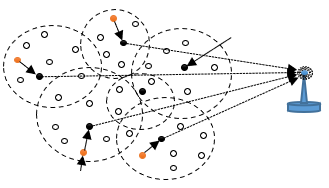Evaluation of various MAC Protocols for Node Density in Wireless Sensor Networks based on QoS
Main Article Content
Abstract
A wireless sensor network is a collection of sensor nodes that communicate with one another to gather data and send it to a base station. The quality of service provided by sensor networks determines their efficiency and lifetime. Energy, channel capacity, packet transmission, packet drop, and latency are all factors in QoS. In WSNs, routing protocols are designed to discover the shortest route to a network's destination, whereas MAC protocols are designed to transmit data through a communication channel. To increase the network's life span, the best routing and MAC protocols are required for communication. In this research, we examined the performance of different MAC protocols for a variety of QoS measures as node density increased. Future researchers will benefit from this research in establishing the best hybrid protocols for wireless sensor networks. The results demonstrate that CSMA is the best communication protocol among the others.
Article Details
References
Kashif Naseer Qureshi, Muhammad Umair Bashir, Jaime Lloret, Antonio Leon, "Optimized Cluster-Based Dynamic Energy-Aware Routing Protocol for Wireless Sensor Networks in Agriculture Precision", Journal of Sensors, vol. 2020, Article ID 9040395, 19 pages, 2020.
K. Muthukumaran; K. Chitra; C. Selvakumar. Energy efficient clustering in wireless sensor networks. 2017 International Conference on Inventive Computing and Informatics (ICICI) 23-24 Nov. 2017.
Kumar, Vipin & Kumar, Sushil. (2016). Energy Balanced Position-based Routing for Lifetime Maximization of Wireless Sensor Networks. Ad Hoc Networks. 52. 10.1016/j.adhoc.2016.08.006.
Ketshabetswe, L. K., Zungeru, A. M., Mangwala, M., Chuma, J. M., & Sigweni, B. (2019). Communication protocols for wireless sensor networks: A survey and comparison. Heliyon, 5(5), e01591.
Girish R. Deshpande, Shrinivas R. Dhotre, Parutagouda S. Khangoudar, Sudhindra K. Madi, Mohammad AsifRaibag. Delay and Lifetime Issues for Wireless Sensor Networks. International Journal of Innovative Technology and Exploring Engineering (IJITEE) ISSN: 2278-3075, Volume-8, Issue- 6S4, April 2019.
Qu, S., Zhao, L. & Xiong, Z. Cross-layer congestion control of wireless sensor networks based on fuzzy sliding mode control. Neural Computing and Applications 32, 13505–13520 (2020).
Zhao, L., Qu, S., Huang, X., & Luo, J. (2019). Congestion Control of Wireless Sensor Networks using Discrete Sliding Mode Control. 2019 Chinese Control and Decision Conference (CCDC)
Yang, X., Chen, X., Xia, R., & Qian, Z. (2018). Wireless Sensor Network Congestion Control Based on Standard Particle Swarm Optimization and Single Neuron PID. Sensors, 18(4), 1265.
Joy Iong-Zong Chen · Chu-Hsing Lin,” Throughput Evaluation of a Novel Scheme to Mitigate the Congestion overWSNs”, wireless communication Springer journals, pp. 1863-1877, 2014.
Dattatray S Waghole, Vivek S Deshpande, “Characterization of wireless sensor networks for traffic & delay”, IEEE conf on Cloud & Ubiquitous Computing & Emerging Technologies, pp. 69-72, 2013.
Dattatray S Waghole, Vivek S Deshpande, “Reducing delay data dissemination using mobile sink in wireless sensor networks”, international Journal of Soft Computing and Engineering (IJSCE), vol 3 issue 1, pp. 305-308, 2013.
Viktor Richert, BijuIssac, and NaumanIsrar, “Implementation of a Modified Wireless Sensor Network MAC Protocol for Critical Environments”, Wireless Communications and Mobile Computing Volume 2017 (2017), Article ID 2801204, 23 pages.

